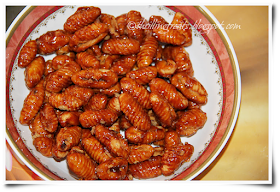Kalchina vankayalu or roasted brinjals is a Telangana recipe, popular in other parts of AP too. For brinjal lovers like us, it is just a bonanza. Whenever Amma made them, there used to be a war at home and the winner, of course got one brinjal or sometimes just 3/4ths a brinjal more than the runner up.
Ingredients:
Fresh long brinjals (Podugu/kalyani vankaylu/Baingan)
Refined cooking oil 1 cup
Mustard seeds (Aavalu/Rai) ½ tsp
Black gram (uddipappu/Uraddal) 2 tsp
Red chillies 2-4
A Handful of curry leaves
Pinch of asafoetida (Inguva/Hing)
Red chilli powder to taste
Salt to taste

Method:
Note: We haven’t mentioned the preparation time, servings as that depends on the number of brinjals. And the quantity of brinjals depends on how many of them you would love having.
We need to prepare 3 things for this recipe: the tempering, spice and of course the roasted brinjals.
For the tempering, heat the whole oil in a deep-bottom pan, add mustard seeds and as they pop, add the red chillies, black gram, curry leaves and a pinch of asafoetida. Pour the whole oil into a serving bowl.
For the spice, mix dry red chilli powder and salt together to taste.
For this recipe, we can and should use only the long finger like brinjals. The round ones, small or large won’t fit in anyway.
Wash, dry and apply oil to the long brinjals and roast/fry directly on heat/flame like the big brinjals are roasted for baingan bhartha. Keep turning the brinjals to ensure they are roasted completely. Continue the process for as many brinjals as required. (If using a microwave oven/grill, place 4-5 brinjals at equal distance and roast for the same time as the big brinjals are roasted for the baingan bhartha i.e. around 10 mins).
Set the brinjals aside to cool. Peel the outer skin (it withers off easily, coz it is roasted). Ensure the brinjals are not spoilt - run the thumb through the brinjal and look inside each one. Cut the green stem on top.
Serve the roasted brinjals, tempering oil, salt and red chilli powder mixture and hot and cooked plain white rice together. Kalchina vankayalu are rice supplements only.
Mash each brinjal onto the rice, sprinkle the salt and red chilli powder mix, pour the seasoning and a tsp of oil and mix the rice. Check and adjust the spiciness.
Enjoy hot kalchina vankayalu or roasted brinjals and rice. For true purple brinjal lovers, this is a delight that will leave them dreaming about when they are going to have it next. ( Amma, we are waiting for ours!)







